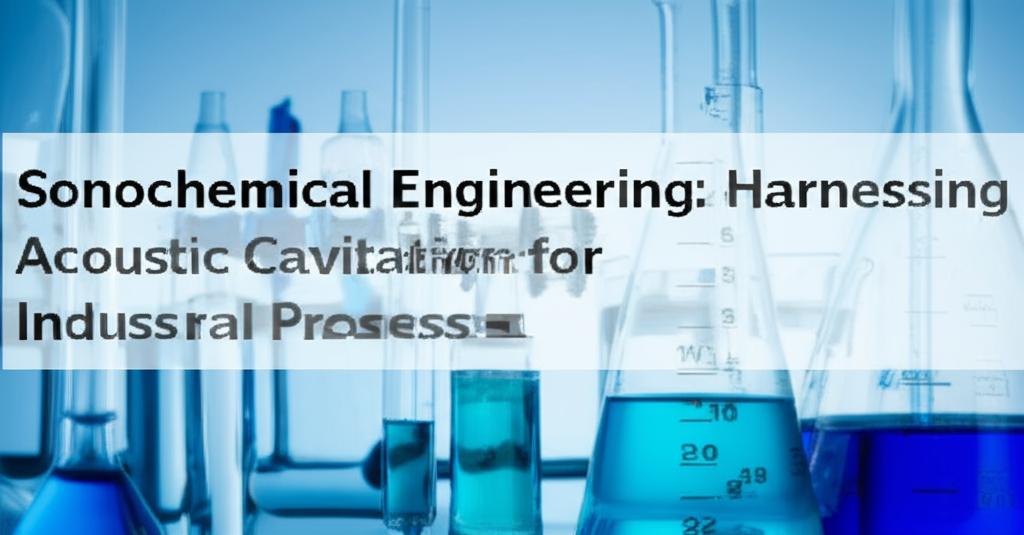Sonochemical engineering leverages the power of acoustic cavitation—the formation, growth, and implosive collapse of bubbles in a liquid irradiated with high-intensity ultrasound—to drive chemical reactions and physical transformations. This rapidly evolving field offers innovative solutions for a wide range of industrial processes, promising enhanced efficiency, reduced energy consumption, and environmentally friendly alternatives to conventional methods.
At the heart of sonochemistry are the extreme conditions generated during cavitation bubble collapse: localized temperatures reaching thousands of Kelvin, pressures up to hundreds of atmospheres, and rapid heating and cooling rates. These "hot spots" create unique chemical environments, facilitating reactions that might otherwise require harsh conditions or be kinetically slow.
Key Industrial Applications & Recent Advancements:Sonochemical engineering is no longer confined to laboratory-scale synthesis and is finding increasing traction in diverse industrial sectors:
- Materials Synthesis & Modification: Ultrasound is a versatile tool for producing novel nanomaterials with unique properties. It can be used for:
Nanoparticle Synthesis: Sonochemical methods, including hydrodynamic cavitation (HC), are proving effective for the industrial-scale synthesis of nanomaterials like nanocarbons, offering good scalability and high effectiveness.
Crystal Engineering (Sonocrystallization & Sonofragmentation): Ultrasound can control crystal size and morphology, prevent agglomeration, and even induce the formation of specific polymorphs. Recent research demonstrates its potential in producing enantiomerically pure crystals from racemic solutions.
Surface Modification & Coatings: Sonochemical techniques are employed to create uniform, protective, and functional micron-thin coatings. This is particularly relevant for applications in electronics (moisture resistance, antimicrobial properties), medical devices (antimicrobial coatings to combat healthcare-associated infections), and automotive and construction industries (durability). Companies like Sono-Tek are developing ultrasonic coating systems for specific markets like EMI shielding for semiconductor packages.
- Environmental Remediation: Acoustic cavitation is a powerful tool for degrading persistent organic pollutants in water and wastewater. The generated hydroxyl radicals and other reactive species can break down complex contaminants.
Advanced Oxidation Processes (AOPs): Sonochemistry is increasingly used as an AOP, often in combination with other technologies like ozonation, electrolysis, or catalysts, to achieve high disinfection and pollutant degradation efficiencies.
Sludge Pretreatment: Ultrasound effectively pretreats sludge in wastewater treatment plants, enhancing biogas production.
- Food Processing & Extraction:
Extraction of Bioactive Compounds: Sonication enhances the extraction efficiency of natural medicines and food components from plant materials by disrupting cell walls and improving solvent penetration.
Pasteurization (Thermosonication): Ultrasound can reduce the temperature required for pasteurization, preserving the flavor of food products.
Emulsification: Ultrasound is used to create stable emulsions for food and pharmaceutical applications.
Starch Modification: Ultrasonic treatment modifies the structure and physicochemical properties of starch, offering green and efficient alternatives for food and industrial applications. While much progress is in the lab or pilot stage, the development of industrial-scale equipment is ongoing.
- Pharmaceutical & Biomedical Applications:
Drug Delivery Systems: Ultrasound is being explored for targeted drug delivery.
Sonodynamic Therapy (SDT): This emerging area uses ultrasound to activate sonosensitizers for therapeutic purposes.
While ultrasonic cleaning and imaging are established, the translation of more advanced sonochemical applications into clinical practice faces challenges related to optimizing parameters and minimizing side effects.
- Chemical Synthesis: Sonochemistry can accelerate reaction rates, improve yields, and sometimes alter reaction pathways. It is increasingly viewed as a "green" technology due to its potential to enable reactions under milder conditions and reduce waste.
- Process Intensification: Ultrasound is a key technology for process intensification, aiming to make chemical processes smaller, safer, and more energy-efficient. This includes enhancing mixing, mass transfer, and reaction rates in both batch and continuous flow reactors.
Despite significant progress, several challenges remain in the widespread industrial adoption of sonochemical engineering:
- Scale-up: Transitioning from laboratory-scale setups to large-scale industrial reactors remains a primary hurdle. Designing efficient and uniform sonoreactors for large volumes is crucial. Hydrodynamic cavitation (HC) is showing promise for easier scale-up compared to acoustic cavitation (AC) in some applications.
- Energy Efficiency: While sonochemistry can offer energy savings in some processes, the energy efficiency of ultrasonic equipment itself needs continuous improvement.
- Understanding Complex Mechanisms: A deeper understanding of bubble dynamics, the distribution of cavitation activity within reactors, and the precise mechanisms of sonochemical effects is needed for optimizing processes and reactor design. Advances in modeling and simulation are contributing to this.
- Standardization & Optimization: Developing standardized methods for characterizing cavitation fields and optimizing operating parameters (frequency, power, reactor design, temperature) for specific applications is ongoing.
- Integration with Other Technologies: Combining ultrasound with other techniques (e.g., electrochemistry, photochemistry, catalysis) often leads to synergistic effects and enhanced performance. Research into these hybrid systems is a growing area.
- Cost: The initial investment cost for industrial-scale ultrasonic equipment can be a barrier for some industries.
The future of sonochemical engineering looks bright, with ongoing research focused on overcoming these challenges. The trend is towards developing more sophisticated reactor designs, including continuous flow reactors and microreactors, improving energy efficiency, and integrating sonochemistry with other green and sustainable technologies. As our understanding of the fundamental principles of acoustic cavitation deepens, so too will the range and effectiveness of its industrial applications, paving the way for a quieter revolution in modern science and industry.

